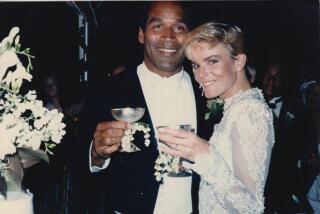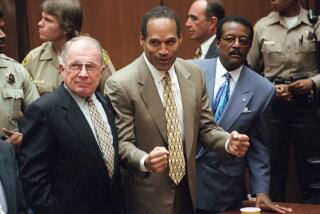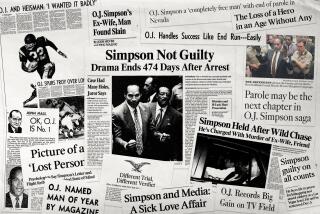Kaelin Admits Changing His Testimony on Simpson : Courts: Prosecutor Clark intensifies her bid to discredit the witness. But the strategy poses a risk.
- Share via
Completing her about-face with her own witness, Deputy Dist. Atty. Marcia Clark stepped up her attempt to discredit Brian (Kato) Kaelin on Monday, first having him declared an adverse witness and then wresting his admission that he had changed his testimony about O.J. Simpson’s demeanor on the evening before the June 12 killings.
In a court day cut short by a bomb scare--the fourth since the trial began--and by a juror’s need to attend a family funeral, Clark also suggested that O.J. Simpson and his ex-wife had argued on the day of the killings that he is charged with. But she offered no evidence to support that contention, and Kaelin said Simpson had not told him of any argument.
Simpson has pleaded not guilty to the murders of Nicole Brown Simpson and Ronald Lyle Goldman.
The wrangling over Kaelin’s testimony filled the entire abbreviated court day, but prosecutors also filed a motion on DNA testing in which they suggested that the defense team was struggling to produce test results that would help its case and in which they threatened a blistering attack on a potential defense scientific expert, controversial scientist Kary Mullis. Mullis, a Nobel Prize winner who invented one form of DNA testing, also is widely known in the scientific community for his unorthodox views and his personal habits, both of which prosecutors pledged to use against him.
“This should prove to be a lively event!” the prosecution pledged in its motion, signed by Alameda County Deputy Dist. Atty. Rockne P. Harmon, who has been brought in to assist in the Simpson case.
Clark had turned increasingly steely with Kaelin last week, but Monday’s confrontation was their most intense, so sharp that defense lawyer Robert L. Shapiro raised their conflict when it was again his turn to question the witness.
“Does she make you uncomfortable?” Shapiro asked Kaelin, who appeared downcast in his fourth day on the witness stand.
“With certain questions, yes,” Kaelin responded.
“And why is that?” Shapiro asked.
“Because I’m trying to do my best,” Kaelin answered.
Although she had become more and more pointed in her questioning of Kaelin toward the end of last week, Clark’s attack Monday was by far her sharpest, and it posed certain risks for the prosecution: Even as prosecutors want the jury to doubt Kaelin’s credibility when he describes Simpson’s demeanor and his relationship with his ex-wife, they insist that Kaelin is reliable when he testifies about the timeline of the night of the killings.
Some legal observers warned that Clark’s mission was exceptionally delicate, because her attempts to discredit Kaelin on the points that hurt the prosecution could spill over and taint his testimony regarding those areas in which they need the jury to accept him as credible. Nevertheless, some analysts gave her high marks for her handling of that task.
“I don’t think she undercut his testimony on the objective evidence by pointing out that on more subjective evidence, he’s trying to bend over backward to help Simpson,” said Loyola Law School professor Laurie Levenson. “In fact, it makes the point for the jury--that if this witness says anything that hurts O.J. Simpson then it has to be true because, when he can, he will try to help Simpson.”
Levenson added, however, that the detailed and confrontational questioning of Kaelin about Simpson’s character could create the impression that his testimony on other subjects did not help the prosecution.
“The jury might lose sight that the most valuable evidence for the prosecution that Kaelin provides is that O.J. has no alibi, that Kaelin heard the thumps on the wall and that Kaelin saw the blood drops before O.J. returned from Chicago and gave blood to the police,” she said.
That dichotomy of Kaelin’s account--between his positive feelings toward Simpson and his potentially incriminating observations on the night of the killings--lent a schizophrenic air to Clark’s questioning, but the testimony ended on the note that prosecutors hope jurors will remember, Kaelin’s insistence that he cannot support Simpson’s alibi.
Authorities believe that Goldman and Nicole Simpson were killed about 10:15 p.m. on June 12 outside Nicole Simpson’s Bundy Drive condominium.
“Can you tell this jury where the defendant was between 9:35 and 11 p.m. (on June 12)?” Clark asked.
“No,” Kaelin said.
“Can you tell this jury that the defendant was not at 875 S. Bundy between 9:35 and 11 p.m.?” she continued. An objection blocked Kaelin from answering, but Clark then ended that round of her questioning.
Shapiro sought to downplay the significance of that testimony, however, by eliciting Kaelin’s testimony that he does not normally check up on Simpson and thus could not be expected to account for Simpson’s whereabouts on most evenings, not just the night of the murders. Kaelin also testified that he never saw Simpson leave the house that evening, meaning that while he cannot be sure Simpson was home during the key period, he cannot say Simpson left the mansion either.
Despite the fact that Kaelin was called by prosecutors, it was Shapiro who sought to shore up the witness’s credibility--particularly his recollections about Simpson’s abilities as a father and his attempts to reconcile with his ex-wife.
Shapiro also belittled his adversary’s attack on Kaelin’s inconsistent testimony. Kaelin admitted that he sometimes described Simpson as upset when discussing the end of his reconciliation attempts with Nicole Simpson and other times testified that Simpson did not appear angry or agitated on the evening of the murders.
Clark bore down especially hard on Kaelin’s testimony in which he described Simpson’s demeanor as he complained of the short dress his ex-wife was wearing at a dance recital that evening. At first, Kaelin had said Simpson did not appear agitated when he made those comments.
Clark then asked Judge Lance A. Ito for permission to “take the witness as a hostile witness,” a procedural matter that gives attorneys permission to pose leading questions to witnesses because they are uncooperative. Ito asked the lawyers to join him out of earshot of the jury to discuss that request, and sources said he granted it.
Afterward, he instructed the jury to ignore Clark’s comment, but Ito allowed her to launch a more aggressive line of questioning and elicited Kaelin’s acknowledgment that Simpson did in fact seem upset when he described Nicole Simpson’s miniskirt.
Pressed by Clark, Kaelin conceded that he was changing his testimony, but he seemed frustrated and confused, and he struggled to better describe his observations.
Clark used the inconsistencies to elicit Kaelin’s admission that his memory had changed, but under questioning from Shapiro, Kaelin said his different accounts were partly influenced by his difficulty defining Simpson’s degree of agitation--which he clumsily labeled Simpson’s “upsetness.”
“A degree of upset,” Kaelin said at one point, furrowing his thick eyebrows and grasping for words, as he often has during his four occasionally frustrating days on the stand. “It’s such a hard thing to, being upset, uh. It wasn’t throwing things. It wasn’t like that.”
Kaelin, an aspiring actor, tried to mimic the voice Simpson used in that conversation, but admitted he was having difficulty getting it just right.
When the court week ended Thursday, jurors had just heard a cryptic question from Clark to Kaelin, asking whether he knew of the role that Simpson’s maid might have played in a 1989 domestic abuse incident at the Simpson home.
Clark asked Kaelin whether he knew the maid had opened a door to allow O.J. Simpson to beat Nicole Simpson in the early morning hours of Jan. 1, 1989. Ito sustained an objection--Kaelin did not even know the Simpsons in 1989, so any answer he gave would have been based on hearsay--and instructed jurors not to draw any inference from Clark’s question.
But that was not enough to satisfy Simpson’s lawyers, some of whom have been tongue-lashed and sanctioned by Ito for withholding evidence and for asking improper questions. Monday, Shapiro called Clark’s question a deliberate attempt to plant an idea in the minds of jurors, and said it was part of a pattern of prosecutors trying to end the weeks in the trial on high notes, only to later back down from some of their insinuations.
A week earlier, for instance, prosecutors displayed a shovel and large plastic bag to the jury as the court day drew to a close, only to then acknowledge the following Monday that the bag was standard equipment in a Ford Bronco such as the one Simpson owned.
Shapiro called the query to Kaelin about the 1989 incident a “bad-faith question” and asked Ito to tell the jury that the prosecutors had committed misconduct. Shapiro also asked the judge to instruct jurors that they could consider why a prosecutor might pose such an improper question.
Deputy Dist. Atty. Christopher A. Darden rose in defense of the government team, conceding that he had been the one who suggested the question and had passed a note to Clark suggesting that she ask it. But Darden said defense lawyers had raised the question of Simpson’s character by eliciting positive comments from Kaelin, and the prosecutor said government lawyers will launch a more sustained attack on Simpson’s character as the trial progresses.
Kaelin’s knowledge of the 1989 incident might serve to rebut that testimony, Darden said, adding that he thought of the question in the heat of the courtroom conflict.
“We’re in the attack mode, and we attack,” the prosecutor said.
Ito took the defense request under consideration, and when the jury returned, he briefly explained the dispute. He did not tell jurors that he believed the question was posed in bad faith or that prosecutors had committed misconduct, but he did reiterate his previous admonition that jurors should not draw any inferences from the questions posed by lawyers, and he reminded the panel that he had found the question about the 1989 incident inappropriate.
Clark appeared undaunted by that exchange and again posed a surprising question to Kaelin during Monday’s session. Defense lawyers at first objected, but after meeting with Ito at the sidebar conference, Clark was allowed to go forward.
“Isn’t it true Mr. Simpson told you he had a cel phone conversation with Nicole from Riviera Country Club in which they had an argument?” the prosecutor asked Kaelin, for the first time suggesting any fight between the two on the day of the killings.
“No,” Kaelin responded.
Clark also waged a long attempt to discredit a relatively small portion of Kaelin’s testimony from last week, statements in which he said that he believed O.J. and Nicole Simpson had a good relationship and that Simpson was a good father to his two young children. To do that, Clark took him through a series of questions intended to show that Kaelin only had observed Simpson with his children for a few hours during the 18 months that he lived in close proximity to the defendant and his children.
In addition, Clark tried to show that Simpson neglected to care for his children on some occasions, failing to pick them up or drop them off when it was his turn to care for them. Simpson, who has smiled genially through much of Kaelin’s testimony, bristled visibly at that suggestion.
As some of his lawyers met with prosecutors at Ito’s sidebar, Simpson spoke angrily with other members of his defense team. His voice rose to the point that it was audible in the courtroom, and deputies intervened. One placed his hand on Simpson’s shoulder as he attempted to calm him, and Simpson then lowered his voice.
One theme of the prosecution’s many-faceted case has been to suggest that Simpson did not behave naturally on the night of the murders and on the following day. Clark returned to that notion Monday as she questioned Kaelin about Simpson’s instructions to him as he rushed off to catch a flight to Chicago.
Although Kaelin had told Simpson about thumps on his wall that caused him to be alarmed, Simpson never suggested calling the police or the security company, Kaelin acknowledged. Simpson was rushing to the airport at the time, but then called Kaelin from the limousine to ask him to set the house alarm, Kaelin added.
“When he called, he asked you to set the alarm on the house?” Clark asked.
“Yes,” Kaelin said.
“Did he tell you to call the police?” she then asked.
“No,” he responded.
“Did he tell you to call Westec (a security firm)?” she continued.
“No,” Kaelin answered.
“Did he tell you to do anything to investigate the source of those bangs on your wall?” she inquired.
“No,” he said again.
But, as with so many elements of Kaelin’s testimony, his observations often were ambiguous. For while Clark tried to leave the impression that Simpson’s behavior was unusual for a person confronted with a mysterious sound at his house, Shapiro asked Kaelin whether anything seemed strange about Simpson on the afternoon before the murders or as he rushed to leave for the airport later.
“In the early, in the mid-evening of June the 12th, is there any question in your mind that O.J. Simpson was not acting in any unusual manner?” Shapiro asked.
“He was not acting unusual,” Kaelin said. “No.”
Shapiro continued: “And when you saw him again at . . . at 11 o’clock, leaving for the airport, other than being rushed, is there any question that he was not acting in any unusual manner?”
“He was rushed to catch a flight, so if that’s unusual, that, and our contact was brief,” Kaelin responded. “So being rushed, that’s all I could say, yes.”
The bomb scare interruption and early end to Monday’s session frustrated Ito’s desire to impose a longer trial day--part of his effort to speed along the proceedings. But Kaelin is expected to conclude his testimony today as the court embarks on a more rigorous schedule lengthening the court day.
Times staff writer Henry Weinstein contributed to this article.
More to Read
Sign up for Essential California
The most important California stories and recommendations in your inbox every morning.
You may occasionally receive promotional content from the Los Angeles Times.











